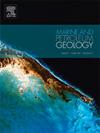Integrated sedimentological and geochemical characterization of the Silurian Qalibah Formation in central Saudi Arabia: Implications to paleoenvironmental reconstruction and organic richness evaluation
IF 3.6
2区 地球科学
Q1 GEOSCIENCES, MULTIDISCIPLINARY
引用次数: 0
Abstract
Unconventional hydrocarbon reservoirs are challenging due to their vertical and lateral heterogeneities. The Silurian Qalibah Formation in Saudi Arabia comprising of the Qusaiba and Sharawra members, serves as a prime example. This study investigates reservoir heterogeneity and variations in depositional conditions to produce a high-resolution chemozonation of the Qalibah Formation. Mineralogical and elemental compositions were determined using X-ray fluorescence (XRF) and X-ray diffraction (XRD), while organic matter characterization was performed using Rock-Eval pyrolysis. Three facies were identified: laminated grey-red mudstones in the Qusaiba Member, heterolithic sandstone-mudstone alternation in the lower Sharawra Member, and thickening upward fine sandstones in the upper Sharawra Member. Clay minerals dominate the Qusaiba Member (50 %), while quartz, mica, and K-feldspars prevail in the Sharawra Member. Organic matter is in early maturation stage with poor-to-fair total organic carbon (TOC) content, averaging 0.2 wt% in the Qusaiba Member and 0.05 wt% in the Sharawra Member. Detrital influx proxies indicate higher sedimentation rates in the Sharawra Member compared to the Qusaiba Member. Paleoclimatic proxies suggest humid to semi-arid conditions in the Qusaiba Member and semi-arid to arid conditions in the Sharawra Member. Paleomarine proxies consistently reveal brackish to saline and suboxic to oxic conditions. Five chemozones were established: three in the Qusaiba Member (Q-1: Ti/P depletion; Q-2: elevated TOC; Q-3: spiking Sr/Ba) and two in the Sharawra Member (S-1: lower Zr/Al and Sr/Cu than S-2). This chemozonation highlights spatial-temporal geochemical variability, offering insights into depositional dynamics and reservoir heterogeneity. The framework supports chemo-steering applications to optimize drilling, enhance reservoir targeting, and improve hydrocarbon recovery in analogous unconventional systems.
沙特阿拉伯中部志留系Qalibah组沉积地球化学综合特征:对古环境重建和有机质丰富度评价的启示
非常规油气藏由于其纵向和横向的非均质性而具有挑战性。沙特阿拉伯的志留系Qalibah组(包括Qusaiba和Sharawra成员)就是一个最好的例子。本研究研究了储层的非均质性和沉积条件的变化,以产生高分辨率的Qalibah组化学分化。采用x射线荧光(XRF)和x射线衍射(XRD)测定矿物和元素组成,采用Rock-Eval热解法进行有机质表征。确定了三种相:曲赛坝段灰红色层状泥岩相、沙拉瓦段下段异质砂岩-泥岩相间相、沙拉瓦段上段细砂岩向上加厚相。古赛坝段以粘土矿物为主(50%),而Sharawra段以石英、云母和钾长石为主。有机质处于早期成熟阶段,总有机碳(TOC)含量较差,居赛坝段平均为0.2 wt%,沙拉瓦段平均为0.05 wt%。碎屑流代用物表明,沙拉瓦段的沉积速率高于古赛坝段。古气候指标显示古赛坝段为湿润至半干旱,沙拉瓦段为半干旱至干旱。古海洋指标一致显示了咸淡水到咸水和缺氧到缺氧的环境。建立了5个化学带:曲赛坝段3个化学带(Q-1: Ti/P衰竭;Q-2: TOC升高;Q-3: Sr/Ba)和2在Sharawra段(S-1: Zr/Al和Sr/Cu比S-2低)。这种化学分化突出了时空地球化学变异性,为沉积动力学和储层非均质性提供了见解。该框架支持化学导向应用,以优化钻井,提高储层定位,并提高类似非常规系统的油气采收率。
本文章由计算机程序翻译,如有差异,请以英文原文为准。
求助全文
约1分钟内获得全文
求助全文
来源期刊

Marine and Petroleum Geology
地学-地球科学综合
CiteScore
8.80
自引率
14.30%
发文量
475
审稿时长
63 days
期刊介绍:
Marine and Petroleum Geology is the pre-eminent international forum for the exchange of multidisciplinary concepts, interpretations and techniques for all concerned with marine and petroleum geology in industry, government and academia. Rapid bimonthly publication allows early communications of papers or short communications to the geoscience community.
Marine and Petroleum Geology is essential reading for geologists, geophysicists and explorationists in industry, government and academia working in the following areas: marine geology; basin analysis and evaluation; organic geochemistry; reserve/resource estimation; seismic stratigraphy; thermal models of basic evolution; sedimentary geology; continental margins; geophysical interpretation; structural geology/tectonics; formation evaluation techniques; well logging.
 求助内容:
求助内容: 应助结果提醒方式:
应助结果提醒方式:


